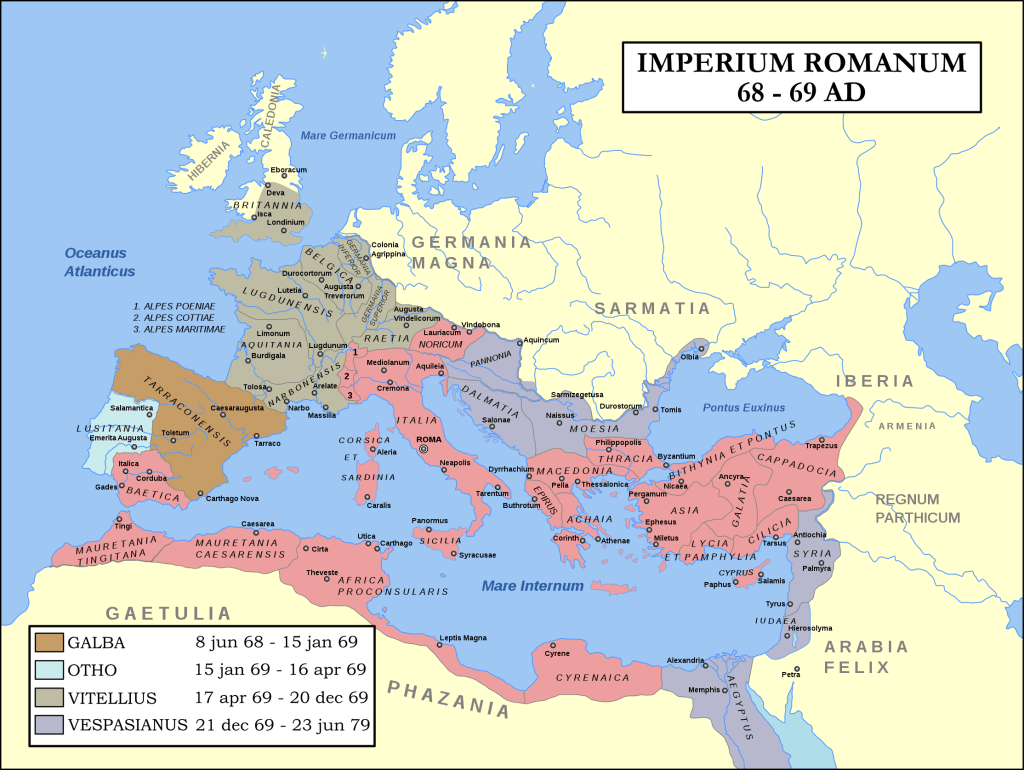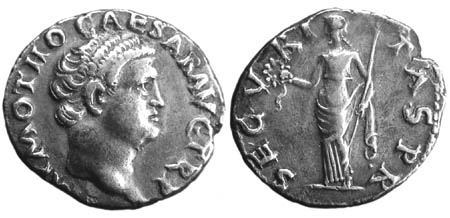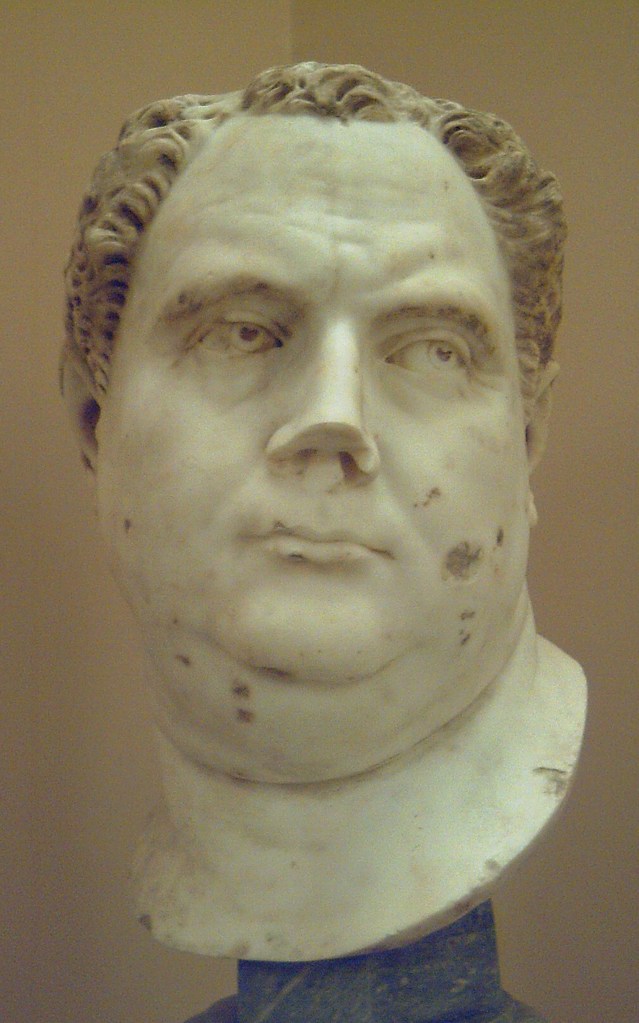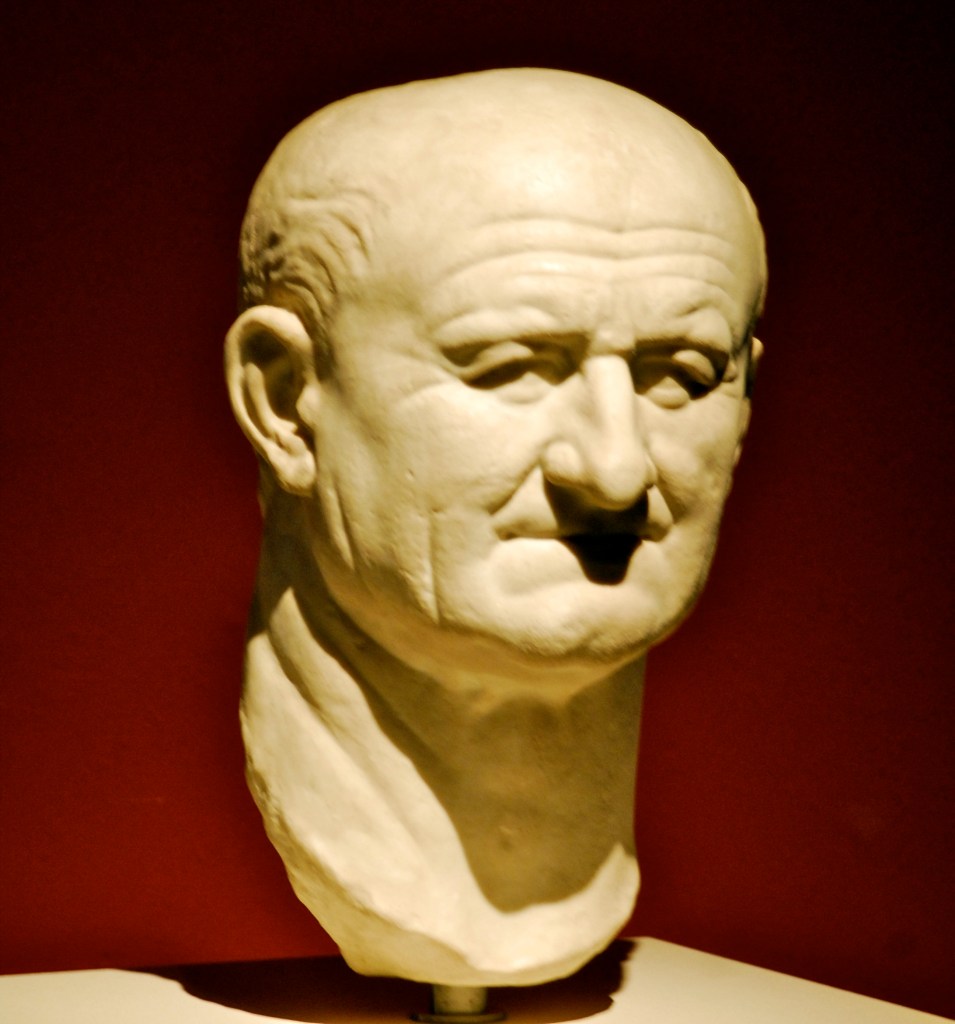使用Player FM应用程序离线!
Special Episode – The Year of the Four Emperors with Dr Rob Cromarty
Manage episode 280283167 series 2782819
We are thrilled to be joined by Dr Rob Cromarty, better known as Doc Crom, for this special episode on the Year of the Four Emperors. Doc Crom, is a teacher, author, and fellow fan of #PhallusThursdays and #FannyFriday over on twitter and we recommend you follow him for his excellent tweets about Latin literature and ancient artefacts.
In this very special episode we talk about his journey into Classics and his take on the personalities and power struggles involved in the aftermath of the death of the Emperor Nero.
Special Episode – The Year of the Four Emperors with Dr Rob Cromarty
What is ‘The Year of the Four Emperors’?
The Emperor Nero made several mistakes in the last few years of his reign. Following the brutal suppression of a serious conspiracy against him, Nero left Rome in the hands of his freedmen so that he could compete in the Olympic Games.
Back in Rome, the people were dealing with low grain supplies. The aristocracy had been alienated for years, and the increasing use of delatores (informers) only made matters worse. The army was also on edge after the execution of talented generals like Corbulo. The situation in early 68 CE was tense.

The extent of Roman power in the crucial years of 68 and 69 CE. Image courtesy of Wikimedia Commons.
That’s Revolting
The Year of the Four Emperors really kicks off with rebellion. In March, Caius Julius Vindex, then stationed in Gaul, revolted in protest against Nero’s tax policy. Some problems never change. Servius Sulpicius Galba, an old associate of some of the Julio-Claudians, was stationed in Spain and decided to throw his lot in with Vindex.
Vindex’s rebellion was put down by Lucius Verginius Rufus, and Galba was declared a public enemy. But that did not last long. The Praetorian Prefect, Nymphidius Sabinus, promised the guard a hefty donative to transfer their allegiance from Nero to Galba, and before long the Senate had made Nero himself a public enemy.
The First of the Four
Galba became emperor in June 68 CE after the suicide of Nero. As a stern, experienced candidate, he must have seemed like a promising choice. However, he soon acquired something of a reputation. According to sources, his assumption of power involved the death of many, and he was stingy with money. Most importantly, he did not provide soldiers with the bonuses they had been promised in exchange for their support. As Tacitus (Hist. 1.49.6) remarked, “…no one would have doubted his ability to reign had he never been emperor.”
Galba was also 73 years old and had no children. This didn’t bode well for stability, and so he decided to focus on improving his position in this area by adopting Lucius Calpurnius Piso in January of 69 CE, a deliberate snub to one of his most prominent supporters – Otho.

A portrait bust of the Roman emperor Galba. This piece is held in the Antiquities Museum in the Royal Palace, Stockholm. Photo credit to Wolfgang Sauber via Wikimedia Commons.
The Year of the Four Emperors, Take Two
To say that Otho was displeased is an understatement. He bribed the Praetorians to back his cause; after all, they weren’t getting bonuses from Galba! On the 15th of January 69 CE, Piso and Galba were assassinated in the forum. Otho thus became the first emperor to unequivocally acquire power by killing the previous emperor. Otho was well known as he had been a prominent member of Nero’s court; indeed, Nero’s most beloved wife, Poppaea Sabina, had once been married to Otho. Unlike Galba, who sought to distance himself from Nero and condemn his reputation, Otho played on the connection.
However, he faced challenges from the outset. Otho became emperor on 15th January 69 CE and took control of the city of Rome, but another would-be emperor had already taken initiative. The soldiers in Germania Inferior refused to swear loyalty to Galba on the 1st January 69 CE, soon to be followed by the troops of Germania Superior. Vitellius had been stationed in Germania Inferior by Galba, and he began to organise his bid for power. Otho had a lot of support, but his forces were not close by, and he was defeated by Vitellius’ forces at the First Battle of Cremona and driven back to Bedriacum. Rather than prolong the civil war, Otho committed suicide on 16th April 69 CE. But his death would not bring the conflict to an end.

Silver Denarius of Otho, Rome mint. His bare head right, IMP M OTHO CAESAR AVG TR P around / Securitas standing left holding wreath and scepter, SECURITAS P R. RIC 8. BMCRE 17. Sear RCV 2162. Source: accla.org
Looking to learn more about Galba and Otho? We’ve got a vintage episode just for you.
The Third of the Four
Of all the emperors to reign in this period, Vitellius probably has the worst reputation (thank you, Flavians?). He had a good relationship with parts of the army and was a well-known figure from the Julio-Claudian period, but the sources record that he was also a glutton, and associated with actors, chariot-drivers and freedmen.
As Vitellius’ popularity started to decline, another emperor was proclaimed in the east on 1st July 69 CE. A man from a modest background, Titus Flavius Vespasianus, had become a trusted military commander. He was supported by the Prefect of Egypt, Tiberius Julius Alexander, and gradually others joined his cause, including the governor of Upper Pannonia (Primus) and the governor of Syria (Mucianus).
A second Battle of Cremona ensued in September 69 CE between the Vitellians and some of Vespasian’s supporters. By December, Vespasian’s men were in Rome itself, and Vitellius was located and slaughtered in the Forum.

This portrait of Vitellius is based on the bust held by the Capitoline Museums in Rome. This particular example is held by the Royal Academy of Fine Arts of San Fernando in Madrid. Photo credit: Luis García (Zaqarbal) via Wikimedia Commons
What’s going on with Otho and Vitellius? Tune into our classic episode for more details.
A New Dynasty Begins!
The year of the four emperors draws to a close with Vespasian. He managed to hold on to power for the next ten years, and was succeeded by his two sons, establishing the second dynasty of imperial Rome.
But how much did his victory influence the historical accounts of this time?
Join us as we discuss the ins and outs of this complicated period, which actually lasted for longer than just one year.

Portrait of Titus Flavius Vespasian, who emerges as a stable ruler from the chaotic years of 68 and 69 CE. Photo credit: Heribert Pohl via Wikimedia Commons
Major Primary Sources
- Suetonius, The Twelve Caesars, the lives of Nero, Otho, Galba, Vitellius, and Vespasian
- Tacitus, The Histories
Sound Credits
- Musical interludes by Bettina Joy de Guzman. Check out her work, it’s fabulous!
- Additional sound effects: Fesliyan Studios, the BBC, Sound Bible, and Pond5
160集单集
Manage episode 280283167 series 2782819
We are thrilled to be joined by Dr Rob Cromarty, better known as Doc Crom, for this special episode on the Year of the Four Emperors. Doc Crom, is a teacher, author, and fellow fan of #PhallusThursdays and #FannyFriday over on twitter and we recommend you follow him for his excellent tweets about Latin literature and ancient artefacts.
In this very special episode we talk about his journey into Classics and his take on the personalities and power struggles involved in the aftermath of the death of the Emperor Nero.
Special Episode – The Year of the Four Emperors with Dr Rob Cromarty
What is ‘The Year of the Four Emperors’?
The Emperor Nero made several mistakes in the last few years of his reign. Following the brutal suppression of a serious conspiracy against him, Nero left Rome in the hands of his freedmen so that he could compete in the Olympic Games.
Back in Rome, the people were dealing with low grain supplies. The aristocracy had been alienated for years, and the increasing use of delatores (informers) only made matters worse. The army was also on edge after the execution of talented generals like Corbulo. The situation in early 68 CE was tense.

The extent of Roman power in the crucial years of 68 and 69 CE. Image courtesy of Wikimedia Commons.
That’s Revolting
The Year of the Four Emperors really kicks off with rebellion. In March, Caius Julius Vindex, then stationed in Gaul, revolted in protest against Nero’s tax policy. Some problems never change. Servius Sulpicius Galba, an old associate of some of the Julio-Claudians, was stationed in Spain and decided to throw his lot in with Vindex.
Vindex’s rebellion was put down by Lucius Verginius Rufus, and Galba was declared a public enemy. But that did not last long. The Praetorian Prefect, Nymphidius Sabinus, promised the guard a hefty donative to transfer their allegiance from Nero to Galba, and before long the Senate had made Nero himself a public enemy.
The First of the Four
Galba became emperor in June 68 CE after the suicide of Nero. As a stern, experienced candidate, he must have seemed like a promising choice. However, he soon acquired something of a reputation. According to sources, his assumption of power involved the death of many, and he was stingy with money. Most importantly, he did not provide soldiers with the bonuses they had been promised in exchange for their support. As Tacitus (Hist. 1.49.6) remarked, “…no one would have doubted his ability to reign had he never been emperor.”
Galba was also 73 years old and had no children. This didn’t bode well for stability, and so he decided to focus on improving his position in this area by adopting Lucius Calpurnius Piso in January of 69 CE, a deliberate snub to one of his most prominent supporters – Otho.

A portrait bust of the Roman emperor Galba. This piece is held in the Antiquities Museum in the Royal Palace, Stockholm. Photo credit to Wolfgang Sauber via Wikimedia Commons.
The Year of the Four Emperors, Take Two
To say that Otho was displeased is an understatement. He bribed the Praetorians to back his cause; after all, they weren’t getting bonuses from Galba! On the 15th of January 69 CE, Piso and Galba were assassinated in the forum. Otho thus became the first emperor to unequivocally acquire power by killing the previous emperor. Otho was well known as he had been a prominent member of Nero’s court; indeed, Nero’s most beloved wife, Poppaea Sabina, had once been married to Otho. Unlike Galba, who sought to distance himself from Nero and condemn his reputation, Otho played on the connection.
However, he faced challenges from the outset. Otho became emperor on 15th January 69 CE and took control of the city of Rome, but another would-be emperor had already taken initiative. The soldiers in Germania Inferior refused to swear loyalty to Galba on the 1st January 69 CE, soon to be followed by the troops of Germania Superior. Vitellius had been stationed in Germania Inferior by Galba, and he began to organise his bid for power. Otho had a lot of support, but his forces were not close by, and he was defeated by Vitellius’ forces at the First Battle of Cremona and driven back to Bedriacum. Rather than prolong the civil war, Otho committed suicide on 16th April 69 CE. But his death would not bring the conflict to an end.

Silver Denarius of Otho, Rome mint. His bare head right, IMP M OTHO CAESAR AVG TR P around / Securitas standing left holding wreath and scepter, SECURITAS P R. RIC 8. BMCRE 17. Sear RCV 2162. Source: accla.org
Looking to learn more about Galba and Otho? We’ve got a vintage episode just for you.
The Third of the Four
Of all the emperors to reign in this period, Vitellius probably has the worst reputation (thank you, Flavians?). He had a good relationship with parts of the army and was a well-known figure from the Julio-Claudian period, but the sources record that he was also a glutton, and associated with actors, chariot-drivers and freedmen.
As Vitellius’ popularity started to decline, another emperor was proclaimed in the east on 1st July 69 CE. A man from a modest background, Titus Flavius Vespasianus, had become a trusted military commander. He was supported by the Prefect of Egypt, Tiberius Julius Alexander, and gradually others joined his cause, including the governor of Upper Pannonia (Primus) and the governor of Syria (Mucianus).
A second Battle of Cremona ensued in September 69 CE between the Vitellians and some of Vespasian’s supporters. By December, Vespasian’s men were in Rome itself, and Vitellius was located and slaughtered in the Forum.

This portrait of Vitellius is based on the bust held by the Capitoline Museums in Rome. This particular example is held by the Royal Academy of Fine Arts of San Fernando in Madrid. Photo credit: Luis García (Zaqarbal) via Wikimedia Commons
What’s going on with Otho and Vitellius? Tune into our classic episode for more details.
A New Dynasty Begins!
The year of the four emperors draws to a close with Vespasian. He managed to hold on to power for the next ten years, and was succeeded by his two sons, establishing the second dynasty of imperial Rome.
But how much did his victory influence the historical accounts of this time?
Join us as we discuss the ins and outs of this complicated period, which actually lasted for longer than just one year.

Portrait of Titus Flavius Vespasian, who emerges as a stable ruler from the chaotic years of 68 and 69 CE. Photo credit: Heribert Pohl via Wikimedia Commons
Major Primary Sources
- Suetonius, The Twelve Caesars, the lives of Nero, Otho, Galba, Vitellius, and Vespasian
- Tacitus, The Histories
Sound Credits
- Musical interludes by Bettina Joy de Guzman. Check out her work, it’s fabulous!
- Additional sound effects: Fesliyan Studios, the BBC, Sound Bible, and Pond5
160集单集
所有剧集
×欢迎使用Player FM
Player FM正在网上搜索高质量的播客,以便您现在享受。它是最好的播客应用程序,适用于安卓、iPhone和网络。注册以跨设备同步订阅。




